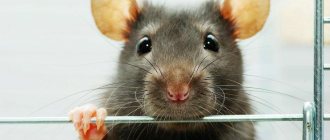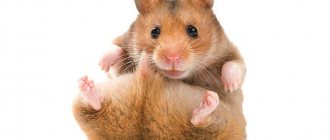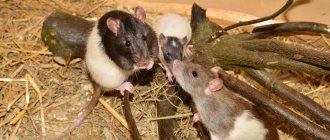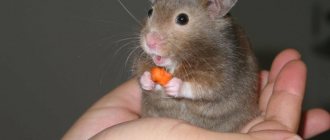The Hamyakov family is about three hundred species of different rodents. It includes not only well-known domestic animals, but also little-known wild animals. These include the Gray hamster - a rodent from the genus Gray hamsters. The habitat is wide - from Europe through Russia, Asia, Mongolia to the Western border of China. Found in Iraq, Iran, Afghanistan, India. Loves arid steppe and desert areas, avoids forests and humid climates. Very often, the gray hamster builds its home in gardens and vegetable gardens, and does not disdain agricultural land.
Appearance
The body length of the animal reaches 10-13 cm, the tail is 4 cm. Weight does not exceed 300 grams. It has small round ears protruding from the fur, an oblong muzzle, and a sharp nose. The eyes are small, black, shiny, and resemble beads. The color of the fur is gray on the sides, there is a dark gray stripe along the back, the abdomen and paws are almost white. Sometimes in nature there are individuals with red patches on their fur. The color of the rodent performs a protective function, because these small animals have many enemies and are completely unable to fight back. Very often, due to their external similarity, the hamster is confused with a field mouse. Their main difference is that the hamster has practically no tail, and its short legs are covered with thick gray hair, and the animal has large cheek pouches.
How to determine the breed of a hamster: algorithm
You need to rely on several points. These are: body length and color.
- Up to 5 cm, white belly and beige-brown back - Roborovsky's hamster.
- Up to 10 cm, with a predominance of gray color, with a black stripe on the back - jungarik.
- About 15 cm and a small tail, golden, uniform in color - Syrian hamster.
- Within 14-15 cm, the abdomen with legs is white, and the back is dark, then this is a Campbell's hamster.
These are the most common breeds to keep at home. If you need to determine the breed of small hamsters, then you should look at their parents, if possible, or focus on color.
Lifestyle
As a rule, he leads a sedentary, solitary lifestyle. The growth of agricultural land led to the fact that the animal gradually began to move closer to humans. The rodent does not like to build its own home; it prefers to move into burrows abandoned by other relatives or mice. It also happens that a gray hamster kills and then gradually eats the owner of the home, if he is smaller. It begins to dig a hole only if there is nothing to choose from. It has a small depth, about 40 or 50 cm, is divided into compartments, and contains several exits. The animal is very economical and picky; each room in its home has its own purpose: for sleeping, storing supplies, a latrine.
This is a gloomy animal, it is most active at night: it is engaged in construction, hunting, searching for food, and storing supplies for the winter. He does not like to go far from his habitat; if this happens, then, having an excellent sense of smell, he easily finds his way home. In winter, it falls into a short hibernation and periodically wakes up to nourish its body. The sleep period lasts about 5 – 6 months, the duration depends on weather conditions.
In nature, an animal can live up to 4-5 years, but this does not happen often, because it has too many enemies: foxes, kites, falcons, owls.
Conditions of detention
Gray hamsters can also be kept at home. To do this, you will need a small cage or aquarium (40/30/30 cm). These animals live well alone, so it is better to keep one or two animals of different sexes in one cage. Individuals of the same sex can conflict.
Sawdust, scraps of paper or hay would be good bedding for animals. The air temperature in the room should be 20–22 degrees. At low temperatures, hamsters can hibernate.
Often kept as pets or laboratory animals.
Pets lead an active lifestyle, so when keeping a house, they need to put a ladder and a special wheel for rodents in their cage. And be careful when opening the door, as pets may jump out.
A box with a hole for entry is suitable for arranging a nest. There the pets will be able to rest and breed. For nesting, they need to be offered pieces of fabric, cotton wool and paper.
Hamsters instinctively store food, even under established feeding patterns. Therefore, the cage needs to be regularly cleaned of perishable supplies. For example, pieces of fresh vegetables or fruits can harm your pet's health. But you can leave the grain and seeds, as they are stored for a long time, and the animal will be calmer.
Female hamsters can give birth to 2 or 3 offspring during the warm season. At one time they give birth to up to 8 cubs. Pregnancy lasts two decades. Once born, hamsters reach sexual maturity after 2–3 months, and manage to give birth to the next generation without waiting for the end of the year.
Features of behavior
The gray hamster has poor eyesight, but excellent hearing, and navigates in space by smell. It has a mild character and shows aggression only towards mice, gophers or its relatives. In case of danger, it always runs away, since its small size does not give it the opportunity to resist a large predator. He tries not to contact people, although he settles near his homes. Due to its nocturnal lifestyle, it is almost impossible to see.
It is distinguished by great cleanliness: the toilet in the hole is made separately from the main place of residence and is cleaned regularly. Takes care of the fur, cleaning it with its hind paws.
Natural enemies of Djungarian hamsters
Photo: What a Djungarian hamster looks like
In their natural habitat, hamsters have a huge number of enemies who constantly hunt them. The nocturnal lifestyle and deep burrows save rodents from some of them.
Natural enemies of hamsters:
- predatory bird species - stoats, owls, hawks, falcons;
- ferrets;
- wild dogs;
- foxes;
- wolves;
- lynx;
- wild cats;
- martens.
Nature has endowed these representatives of the rodent family with excellent hearing, which allows them to detect the slightest rustle at a considerable distance. This ability allows you to determine the approach of an enemy in many situations. If a hamster hears dangerous sounds, it instantly flees. They most often hide in deep holes or other reliable shelters. If the sounds that instill fear are very close and there is no way to escape, the animal simply freezes, wanting to remain unnoticed. If this maneuver does not bring the desired result, the hamster rushes to attack.
In some cases, even large predators are confused by this behavior, giving the small animal a chance to escape. There are a number of diseases to which hamsters are very sensitive. Among the most common diseases that cause death in animals are diabetes and obesity.
Nutrition
The main type of food for a rodent is grain crops: barley, millet, oats, wheat. Eats some types of legumes: beans, peas. Closer to autumn, he feasts on melons and their seeds: melons, watermelons, pumpkin, zucchini. Having climbed into the garden, it eats beets, carrots, sunflower seeds, and corn. Loves fruits and berries. Unlike other wild rodents, the gray hamster does not eat perennial grasses grown in pastures for livestock. In addition to plant foods, its diet includes mollusks, worms, crustaceans, small mice, beetles and ants.
Gray animals are very economical; during the summer they are able to store an amount of food several times greater than their own weight.
What does the Djungarian hamster eat?
Photo: White Djungarian hamster
Djungarians are undemanding when it comes to nutrition, so keeping and feeding them will not be too expensive. This type of pet can safely be called omnivores. The best option for these animals is ready-made balanced types of food specifically for hamsters. The basis of these feeds are granules and grains and cereals. Hamster formulas also include pieces of corn, as well as at least 10-15% proteins.
Be sure to give your hamsters fresh, juicy vegetables and fruits, which the animals love very much. However, it is necessary to promptly remove unused remains and cells in order to avoid rotting and disease of the animals, since animals often not only eat the food allocated to them, but also hide large quantities of them in their cheeks. This is how they stock up on provisions.
The owner must ensure constant access to water. To do this, you can install sippy cups. Another mandatory condition is the introduction into the diet of vitamins and minerals necessary for the normal functioning of hamsters. The animals also need to be fed with fresh herbs and juicy berries. Sometimes it is recommended to give them nuts and sunflower seeds. Hamster breeders should be careful about the source of protein in their hamsters' diet.
It is recommended to give them the following ingredients as protein food:
- boiled chicken liver in small quantities;
- boiled chicken breast;
- low-fat varieties of cottage cheese.
Your hamster should have fresh food every day. Changing the water in the sippy cup is also required daily. It is strictly forbidden to include foods that contain large amounts of sugar in your diet.
Reproduction
Hamsters of this species are fertile. During the summer, females can give birth to up to two litters. The gestation period lasts 20-25 days. One litter can have about 10 cubs. Babies are born blind, deaf and bald. But by the end of the second week of life they can feed on their own. Mothers take care of small hamsters for twenty days, then the young go into adulthood. At the same time, puberty begins, so by the end of the season, young females can bring their own litter.
Despite their good fertility, rodents are listed in the Red Book as an endangered species. This is due to several factors:
- Changing natural landscapes. There are no areas where people are not engaged in economic activities. Constant cohabitation with people leads to the displacement of rodents from their usual habitat.
- Poisoning from chemical fertilizers. Agricultural fields are constantly treated with nitrates and pesticides, which leads to intoxication of the animals’ bodies and their slow and certain extinction.
- A large number of predators. As a rule, a large number of rodents are destroyed by their enemies during puberty. Stupid young animals are hunted by rats, herons, ferrets, and badgers.
Hamsters of this species do not cause damage to agriculture, unlike other wild rodents. They are cute and harmless animals of the steppes and semi-deserts.
Spreading
Distributed from Eastern Europe through Russia and central Asia to Mongolia and to western China. The southern edge of its range passes through Israel, Jordan, Iraq, Iran, Afghanistan, Pakistan and northern India. At first he lived in dry meadows, steppes and semi-deserts. Now it also lives on farmland and in gardens, and sometimes even in houses. Prefers arid areas with relatively sparse vegetation, avoids forests and wet habitats.
In Russia, the gray hamster lives in the European part north to the Moscow region and the mouth of the Kama, in the Caucasus and the south of Western Siberia to the foothills of Altai in the east, in forest-steppes, steppes and populated areas. Brought to Moscow, where it took root in some areas of the city (for example, near the Belorussky railway station). It adheres to dry places, desert depressions, rocks and screes in the mountains, steppe ravines, wastelands and pastures.
Additional questions and answers
There are some important questions to consider before purchasing a rodent. This will help you choose the right animal and provide it with good conditions.
What is the smallest breed of hamster
Roborovsky hamsters are the smallest breed suitable for home keeping. Among wild rodents, “Taylors” stand out for their compact size.
What is the largest breed of hamster
Among domestic breeds, Syrians are considered the largest. Karbysh is the largest wild rodent.
Who is better to get - a Djungarian or a Syrian hamster?
Both breeds have their advantages and disadvantages. Thus, “Syrians” are larger, have an easy-going disposition and quickly learn to respond to a nickname. However, they need a spacious cage. Djungarian hamsters do not require much space. Now many varieties of this breed have been bred, so it is easier to choose an animal with the desired decorative qualities. Syrian hamsters are easier to care for.
Popular Domestic Breeds
In this section of the article, we will look at the types of domestic hamsters that are widespread among people.
Syrian
This breed was first brought to England as a pet by the British Consul in 1880. Due to its most common golden-red color, the Syrian hamster has acquired the second name “golden hamster”. The color of these hamsters can also be black, brown, white, blue, etc. Weight varies between 100-150 grams, body length averages 13-14.5 cm.
Among all breeds, Syrians are long-lived, living about 2.5 years, and with careful care they can live up to 4-6. By nature they are very kind, active and restless animals.
In the wild, it lives in shallow burrows, where it spends most of the daytime. Leads an active nocturnal lifestyle. It feeds on cereal grains, berries, fruits, vegetables, small insects and worms. It has large cheek pouches, which it uses to carry food and raw materials for building nests. These hamsters form pairs only during the mating period, as they prefer a bachelor lifestyle. The female's pregnancy lasts eighteen days, after which four to fourteen cubs are born.
What does such a pet look like, look at the photo:
Dzungarian
This hamster got its name from a province in western China - Dzungaria. A small rodent, reaching a length of only ten centimeters, weighing 35 - 55 grams. The most common color: white legs and belly, grayish-brown back with a black stripe along the entire spine. Life expectancy is up to two years. They are independent in nature, but are easily tamed.
The Djungarian hamster builds a hole for itself with many branches, each of which has its own purpose: bedroom, food storage, toilet. The dzhungarik is a nocturnal animal; it sits in its hole all day, and as soon as it gets dark, it comes out for food. The diet contains a large amount of seeds, berries, grass and insects. Gestation lasts 17-25 days and mostly four to six babies are born.
Campbell
A dwarf hamster that lives in the steppes of Russia, Mongolia, China and Kazakhstan.
The color of this breed has three main types:
- usual color – agouti;
- cinnamon or sand colors - Argentinean;
- white - albino.
Also available in spotted, pearl, blue and black. The body length is on average 8 - 10 cm, the animals weigh no more than 40 grams. They usually live up to 1.5 – 2 years. Nature deprived these hamsters of vision, but compensated with a large number of glands located throughout the body. Campbell's hamsters, unlike Syrian hamsters, prefer to live in a cooperative with their relatives. In captivity, they can live in mixed colonies, that is, females with males, but it is still recommended to keep them separately.
In the wild, deep holes are dug, some of which can be up to two meters deep. Campbell, like all the breeds described above, leads a predominantly nocturnal lifestyle, since many enemies await it on the surface. Natural enemies are birds of prey, foxes, and weasels. These small rodents feed on seeds, vegetables, grains, and berries. They enter the sexually mature period in the fifth week, pregnancy lasts on average twenty days, with a litter of four to seven cubs. It is worth noting that males, along with females, take part in raising offspring, unlike Djungarian and Syrian hamsters.
Taylor
A small animal, barely reaching ten centimeters in length, and weighing no more than 150 grams. This hamster loves a sunny climate, so it has inhabited Central and Southern Mexico, Arizona, Texas, as well as the islands of Aruba and Curacao. For housing, it mainly uses natural holes and depressions located in dense grass. Hamsters prefer tall and dense grass for safety reasons, as it is easy to hide in it and confuse their tracks. The main color is gray, but other colors may occur.
They go out for food at dusk; the main diet includes grass, seeds, roots, insects and butterflies. Pregnancy lasts up to twenty days, with a litter of one to four rodents. In captivity they take root well if taken at a young age. This is a very active and agile animal, constantly on the move.
Chinese
A miniature hamster, common in Northern China and areas of Mongolia. The color of these hamsters can be either regular brown or white-gray with a dark stripe on the back. A distinctive feature is the presence of a long tail, which looks like a rat's tail. Body length is within ten to twelve centimeters, weight up to 200 grams. They are good-natured and active in nature, so in captivity they should be bred in a large room with a wheel, otherwise they will get bored. They feed on grass, seeds, berries and grains.
In the wild they live no more than two years, in captivity they live up to three to four years. The female carries the fetus in her womb for 18 to 21 days, and two or three cubs are born. After giving birth, the female becomes aggressive towards the male. These hamsters are relatively difficult to breed, so they are not often found in pet stores.
Roborovsky
The smallest member of the family. The body length is no more than 5 cm, and the weight is up to 30 grams. With proper care they can live up to four years. Rodents have a snub nose and white eyebrows. The fur color can be golden, cream, sandy or agouti. These animals have a developed social life and interact very well with each other. They cost an order of magnitude more than other breeds, as they do not reproduce well in captivity.











